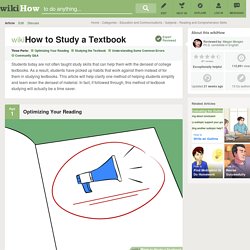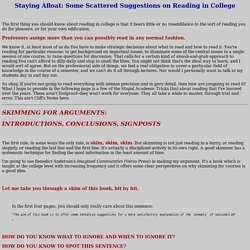

Reading Skills and Strategies for Students. One of the things students soon realize about college is that they must learn most things on their own, and often, this requires them to locate resources outside the classroom.

This is not a foreign idea for those accustomed to finding a tutor in working math problems or writing essays; but, when it comes to asking for help in reading and comprehending a textbook, students are sometimes hesitant to reveal any difficulties they may be experiencing. We all know how to read, right? It’s just a matter of concentrating and re-reading until we get it, right? Wrong. This is a misconception, and it is common. Becoming acquainted with the academic resources of a campus is vital to one’s success, and self-study is key. The following links can get you started, but the more you learn, the more you will want to know. Study Guides and Strategies: This site, available in 39 languages, provides extensive coverage of all things related to student success. How to Study a Textbook. Expert Reviewed Three Parts:Optimizing Your ReadingStudying the TextbookUnderstanding Some Common ErrorsCommunity Q&A Students today are not often taught study skills that can help them with the densest of college textbooks.

As a result, students have picked up habits that work against them instead of for them in studying textbooks. This article will help clarify one method of helping students simplify and learn even the densest of material. In fact, if followed through, this method of textbook studying will actually be a time saver. Ad Steps Part 1 Optimizing Your Reading <img alt="Image titled Study a Textbook Step 1" src=" width="728" height="546" class="whcdn" onload="WH.performance.clearMarks('image1_rendered'); WH.performance.mark('image1_rendered');">1Read the introduction to the textbook first.
<img alt="Image titled Study a Textbook Step 7" src=" width="728" height="546" class="whcdn">7Take a break after every chapter. Part 2 Studying the Textbook Part 3 Understanding Some Common Errors. How to Read in College. Staying Afloat: Some Scattered Suggestions on Reading in College The first thing you should know about reading in college is that it bears little or no resemblance to the sort of reading you do for pleasure, or for your own edification.

Professors assign more than you can possibly read in any normal fashion. We know it, at least most of us do.You have to make strategic decisions about what to read and how to read it. You're reading for particular reasons: to get background on important issues, to illuminate some of the central issues in a single session of one course, to raise questions for discussion. That calls for a certain kind of smash-and-grab approach to reading.You can't afford to dilly-dally and stop to smell the lilies. So okay, if you're not going to read everything with intense precision and in gory detail, then how are yougoing to read it?
The first rule, in some ways the only rule, is skim, skim, skim. Let me take you through a skim of this book, bit by bit. Textbook Reading Strategies: Columbia College: Academic Resources. Reading a college textbook is very different than reading for pleasure.

The amount of reading required in college is much greater than in high school. For many students the increased number and length of college reading assignments is a new demand on their time and energy. They may not be fully prepared to undertake this level of participation. College students need to adopt a reading method that will help increase their comprehension of complex material. Suggestions to maximize comprehension when reading a college text: After buying your textbooks, spend an hour or more surveying the material in each text.
The reading system encouraged at Columbia College is the SQ3R reading method. The following five steps are the components to this reading system: Survey Question Read Recite Review. Reading Your Textbooks Effectively and Efficiently. More details Skip to main content Dartmouth College Academic Skills Center Quick Links Home > Assess your Learning Style >

Reading a Textbook for True Understanding - Cornell College. Many students make the mistake of picking up their textbook and reading 50 pages straight through front to back and assuming they are done with their reading assignment.

These students will often struggle to participate actively in class discussion and may not do well on the tests. There are better methods for getting the most out of your reading. The basics: Multiply the number of pages you have to read by 5 minutes. That is the amount of time the average college student needs to spend on their reading assignment. The system: PreviewRead Actively (includes reading, highlighting, note-taking)Review Let's take a closer look. Preview: You would most likely not travel to another country without getting a lay of the land first. Previewing a textbook accomplishes much the same thing. Now, you have a sense of where you are heading. Read Actively: Do not take notes or highlight as you read; this tends to break up your flow and diminish your understanding.